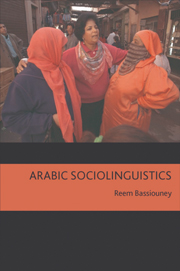Book contents
- Frontmatter
- Contents
- Acknowledgements
- List of charts, maps and tables
- List of abbreviations
- Conventions used in this book
- Introduction
- 1 Diglossia and dialect groups in the Arab world
- 2 Code-switching
- 3 Language variation and change
- 4 Arabic and gender
- 5 Language policy and politics
- General conclusion
- Bibliography
- Index
General conclusion
Published online by Cambridge University Press: 05 August 2013
- Frontmatter
- Contents
- Acknowledgements
- List of charts, maps and tables
- List of abbreviations
- Conventions used in this book
- Introduction
- 1 Diglossia and dialect groups in the Arab world
- 2 Code-switching
- 3 Language variation and change
- 4 Arabic and gender
- 5 Language policy and politics
- General conclusion
- Bibliography
- Index
Summary
In this book, I have first shed light on the diglossic situation and the main groups of dialects in the Arab world. It was established at the beginning that the distinctions made by linguists between CA, MSA and the different vernaculars are not necessarily accepted by native speakers and in some cases not even trusted, as was shown in Chapter 5, in which there were native speakers who were sceptical about linguists and politicians, especially non-Arab ones, discussing their language and linguistic situation. The relation between language and ideology is very much in the forefront of the minds of native speakers. Arabic, in its entirety, is a major means by which people in the Arab world can endow themselves with a sense of belonging and manifest different facets of their identity.
When discussing the structural constraints and discourse functions of both diglossic switching and code-switching, it was apparent that the diglossic situation is more complex than the bilingual one, and that theories that can be applied neatly to bilingual code-switching are challenged by diglossia. In fact, when discussing code-switching, diglossic switching was also examined. When concentrating on quantitative variationist studies in the Arab world, levelling and diglossia were still relevant. MSA phonological variables like the q were juxtaposed with dialectal ones in Egypt, Bahrain and Jordan, to name but a few.
- Type
- Chapter
- Information
- Arabic Sociolinguistics , pp. 273 - 275Publisher: Edinburgh University PressPrint publication year: 2009



